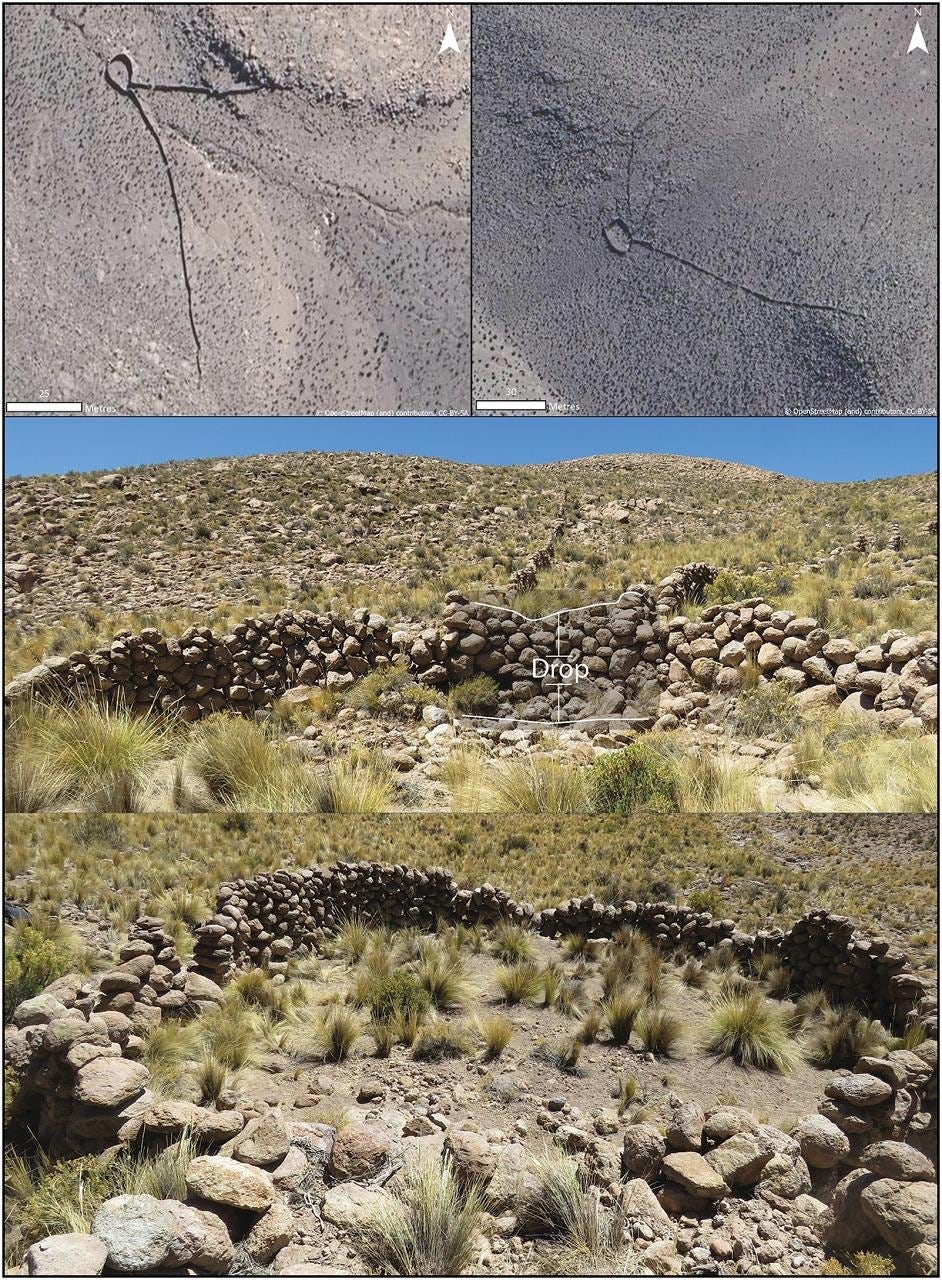🧐 Ancient Beat #170: Scorpion mound observatories, tool making, and two sets of hunting megastructures worlds apart
Hey folks! I’m camping this weekend and stole away for a moment to send this out. There’s a chill in the air, but the fires’s warm. So cozy up — here’s the latest ancient news. 👇 🏕️
🗞 Ancient News: Top 5
Prehistoric Megastructures Reveal Large-Scale Hunting Networks — An airborne laser survey on the Karst Plateau (Adriatic hinterland) uncovered four monumental dry-stone architectures (K01–K04) over ~870 km² (~336 sq mi). Each features long, low funneling stone walls converging into concealed enclosures (some under cliffs or in dolines), likely designed to channel and trap wild ungulates (e.g. red deer). The largest wall spans over 3.5 km (2.2 mi), with wall widths of 1–1.5 m (3.3–4.9 ft) and surviving heights under 0.5 m (~1.6 ft). Though direct dating is lacking, stratigraphic evidence and charcoal radiocarbon dates point to abandonment before the Late Bronze Age, possibly built earlier (even Mesolithic or early Bronze Age). Their scale, terrain integration, and community coordination suggest a degree of social organization not usually ascribed to prehistoric European hunter groups.
Satellite Images Reveal 76 Ancient Hunting Traps in Chile, Uncovering Millennia of Survival in the Andes — High-resolution satellite imagery over a 1,775-square-mile (4,600 km²) stretch of the Camarones River Basin in northern Chile has revealed 76 ancient stone hunting traps and nearly 800 nearby seasonal campsites. Built on steep slopes over 9,000 feet, the V-shaped “chacus” — some extending 500 feet long and funneling into circular pits about 6.5 feet deep — were used to corral vicuñas, wild relatives of alpacas. The scale and distribution of the traps, which may date as far back as 6000 BCE and remained in use into the 18th century CE, show that hunting persisted alongside herding and small-scale farming for thousands of years. This challenges the assumption that foraging vanished with the rise of agriculture. The camps, mostly within 3 miles of the traps, suggest highly mobile groups strategically exploiting mountain ecosystems. The chacus also mirror similar “desert kite” systems in the Middle East and Central Asia, an example of technological convergence driven by shared survival challenges.

Image credit: Adrián Oyaneder, Antiquity (2025); CC BY 4.0 The Myth of a Single Origin: How Two Worlds Shaped the Dawn of Modern Toolmaking — The longstanding narrative that modern humans entered Europe ~45,000 years ago carrying a single, elegant stone tool tradition from the Near East is challenged. While the tool types appear superficially similar between the Levantine Ahmarian and European Protoaurignacian industries, analysis of the production techniques shows major differences. That suggests parallel invention rather than cultural transmission: two Homo sapiens groups—one in the Near East, the other in southern Europe—independently arrived at analogous solutions under similar pressures, rather than one copying the other.
The Hand That Rewrites a Lineage — New hand and foot fossils linked to Paranthropus boisei (dated ~1.52 million years ago) demonstrate a blend of manipulative capability and forceful grip. The wrist, thumb, and finger morphology suggest this species could grasp and possibly make or use tools—challenging the idea that complex tool use was exclusive to Homo. The hand retains robust traits (in line with gorilla-style strength) while overlapping with traits seen in early humans.
Ancient 200-Foot Scorpion-Shaped Mound in Mexico May Have Served as a Solstice Observatory — In Mexico’s Tehuacán Valley, archaeologists documented a rare scorpion-shaped effigy mound about 205 feet (62.5 m) long and up to 31 inches (80 cm) high, dating to roughly 600–1100 CE. Built of stone and soil and remarkably preserved, the mound features a body, claws, and a raised “stinger” aligned with the summer solstice sunrise and winter solstice sunset, possibly helping early farmers track seasonal changes and planting times. Excavations uncovered ceramic jars, tripod molcajetes, incense burners, and a hollow figurine fragment, pointing to ritual activity tied to agriculture. The mound was part of a larger 22-acre (9-hectare) ceremonial-agricultural complex with 12 other mounds and irrigation canals, showing deep integration of astronomy with daily life. Linked to Tlāhuizcalpantēcuhtli, the Venus-associated god of rain and fertility, the effigy reflects both cosmic and agrarian significance. Its likely builders—rural farmers rather than elites—demonstrate how sophisticated astronomical knowledge extended beyond urban centers into community-level practice.
That’s it for the free Top 5! If you’re a free subscriber, sign up for the paid plan for another 25 discoveries and 4 recommended pieces of content covering idles, hoards, and yogurt.
Until next time, thanks for joining me!
-James
Twitter: @jamesofthedrum
P.S. Here’s my Buy Me A Coffee link if you’d like to support my efforts with a donation.
P.P.S. If you want access to the paid version but it’s a little too steep for you right now, just email me — I want this to be accessible.
P.P.P.S. Paid members, read on!
🗞 Ancient News: Deep Dive
Keep reading with a 7-day free trial
Subscribe to Ancient Beat to keep reading this post and get 7 days of free access to the full post archives.

